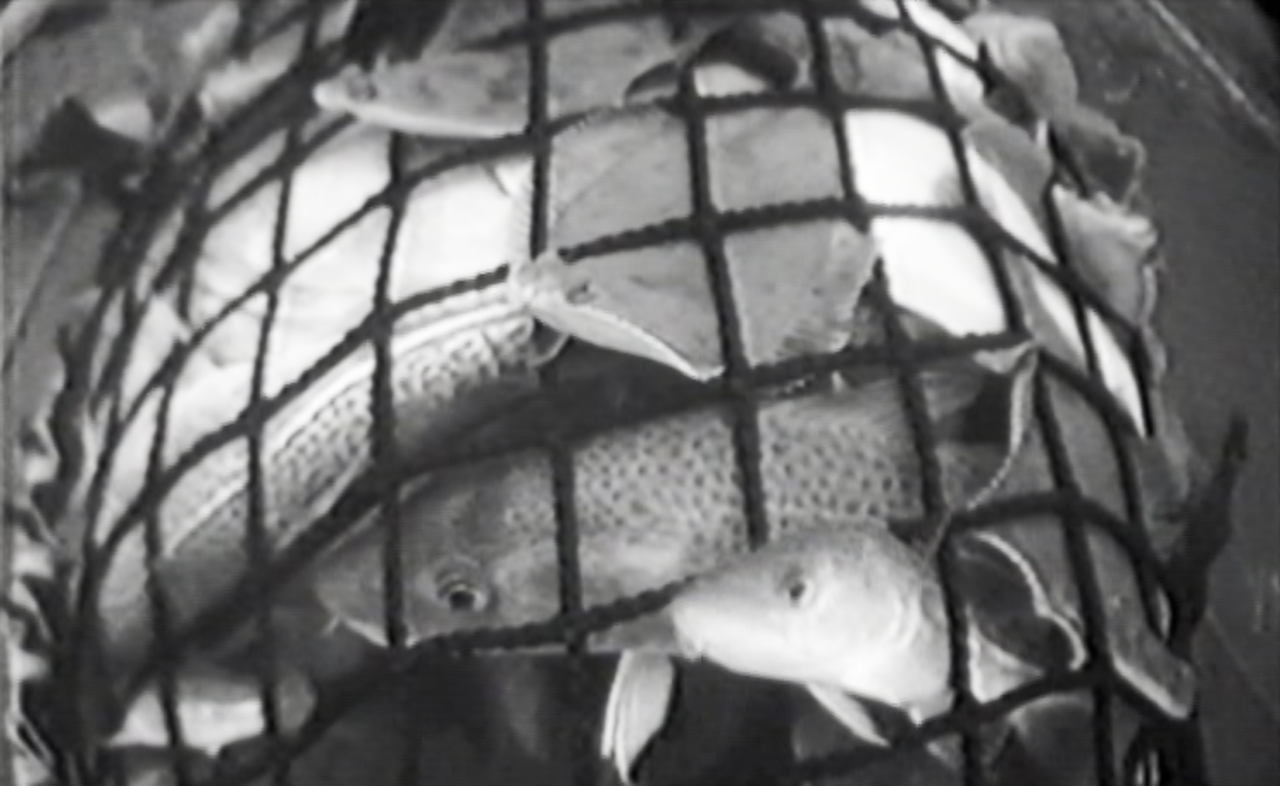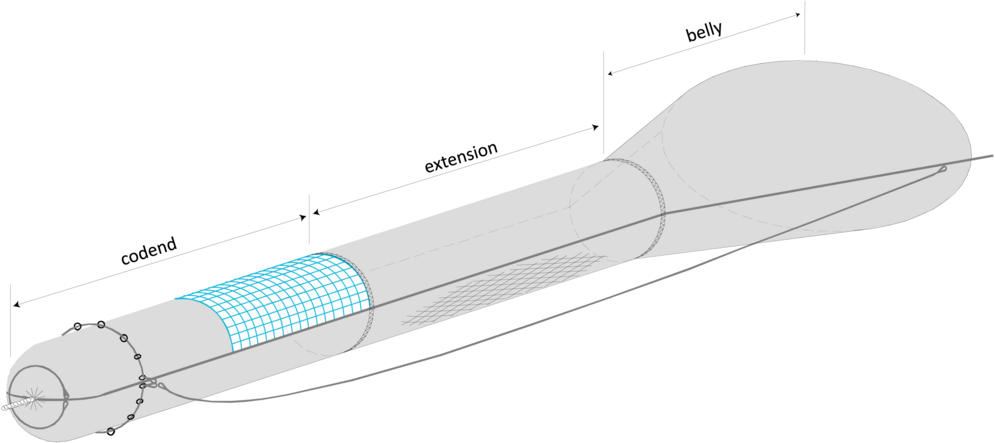Project
Improving selectivity of trawls

Fishery and survey technology: Investigations on net selectivity with the aim of reducing bycatch of target and non-target species in trawls
Development of improved fishing methods, by means of increased gear selectivity.
Background and Objective
The common functionality of trawls is to herd fishes in front of the trawl. These fishes swimm in front of the trawl and flee from the approaching trawl until they are exausted and fall back into the trawl. They are collected at the end of the trawl, which is called codend.
We investigate the selective properties of currently used trawl and codends and work on innovative concepts to further improve their selectivity.
Main topics are:
1. codend-selectivity
At latest inside the codend, the animals give up to avoid net contact. Small fishes can escape through meshes if these meshes are big enough.
The mesh size is often (but not in all cases) adapted to the desired size of the target species. During the last years, the mesh shape was also taken into consideration: square mesh netting is frequently used for target species with round-oval body cross section (roundfish, such as cod or withing).
Further improvement of meshsize and mesh shape, as well as the usage of alternative netting material can help to adapt the selectivity to the need of fishery management and fishery.
2. Multispecies selectivity
In most cases, several species live in a fishing area. Those species differ in terms of growth, behaviour and morphology - most relevant for selectivity is body cross section. A codend, optimized for roundfish species, has a high catchability for flatfish species due to their very wide body shape. In the Baltic for example, some flatfish species are wanted (e.g. turbot). Nevertheless, most flatfish are caught as unwanted bycatch.
We work on solution to sort wanted and unwanted species under water. We call this "multispecies selectivity". To achieve such selectiviy, we need to develop additional sorting devices and to integrate them into the trawl.
3. alternative selectivity concepts
Usually, a trawl catches larger individuals of a given species, while smaller individuals can escape through the meshes. This results in a change of the age structure of the population. Amongst other effects, the high reproductive potential of large individuals can't be used optimal.
We work on alternative concepts for trawl selectivity, where - for example - old individuals have a chance to escape from the trawl.
Approach
Basis of investigations and development is a deep understanding of the bahaviour and morphology of relevant species. Amongst others activities, we conduct intensive underwater observation in trawls. Using this knowledge of animal behaviour we are able to design specific selection devices and to integrate them in the trawl in a way that unwanted species can use them to escape.
This work and the test of new gear designs are conducted on different research vessels (in most cases FRV "Clupea" and FRV "Solea"), as well as on commercial vessels.
Thünen-Contact

Involved Thünen-Partners
Duration
Permanent task 1.2001 - 12.2026
More Information
Project status:
ongoing
Publications
- 0
Sistiaga M, Herrmann B, Brinkhof J, Larsen RB, Santos J, Stepputtis D, Brinkhof I, Jacques N, Cerbule K, Petetta A, Cuende E, Kvalvik L (2023) Is there a limit to the potential effects of shortening lastridge ropes on the size selectivity of diamond mesh codends? Fish Res 262:106671, DOI:10.1016/j.fishres.2023.106671
- 1
Santos J, Furkert F, Stepputtis D, Schütz A (2023) Neues Sortiergitter-Konzept zur Beifangreduktion in der Krabbenfischerei. Fischerblatt 71(12):21-25
- 2
Bak-Jensen Z, Herrmann B, Santos J, Melli V, Stepputtis D, Feekings JP (2023) The capability of square-meshes and fixed-shape meshes to control codend size selection. Fish Res 264:106704, DOI:10.1016/j.fishres.2023.106704
- 3
Bak-Jensen Z, Herrmann B, Santos J, Jacques N, Melli V, Feekings JP (2022) Fixed mesh shape reduces variability in codend size selection. Can J Fish Aquat Sci 79(11):1820-1829, DOI:10.1139/cjfas-2022-0049
- 4
Santos J, Stepputtis D, Oesterwind D, Herrmann B, Lichtenstein U, Hammerl C, Krumme U (2022) Reducing cod bycatch in flatfish fisheries. Ocean Coastal Manag 220:106058, DOI:10.1016/j.ocecoaman.2022.106058
- 5
Stepputtis D, Santos J, Mieske B, Lichtenstein U, Schütz A, Stechert R (2020) Abschlussbericht an das Ministerium für Landwirtschaft und Umwelt Mecklenburg-Vorpommern für das Projekt CODEX (CodExcluder) - Netzmodifikation zur Reduktion des Dorschbeifanges. Rostock: Thünen Institute of Baltic Sea Fisheries, 99 p
- 6
Santos J, Herrmann B, Stepputtis D, Kraak SBM, Gökce G, Mieske B (2020) Quantifying the performance of selective devices by combining analysis of catch data and fish behaviour observations: methodology and case study on a flatfish excluder. ICES J Mar Sci 77(7-8):2840-2856, DOI:10.1093/icesjms/fsaa155
- 7
Stepputtis D, Santos J, Zimmermann C (2020) Technical approaches to avoid cod catches in Baltic Sea trawl fisheries : A report for the BALTFISH high level group. Rostock: Thünen Institute of Baltic Sea Fisheries, 37 p
- 8
Herrmann B, Wienbeck H, Stepputtis D, Ahm Krag L, Feekings JP, Moderhak W (2015) Size selection in codends made of thin-twined Dyneema netting compared to standard codends: a case study with cod, plaice and flounder. Fish Res 167:82-91, DOI:10.1016/j.fishres.2015.01.014

![[Translate to English:] [Translate to English:]](/media/_processed_/d/7/csm_Startseite-OF_03_c0dfd6e750.png)
![[Translate to English:] [Translate to English:]](/media/_processed_/a/3/csm_20181116-151457-Stella-Jerome-Fischfalle-Warnem%C3%BCnde-Dorsche-im-Netzk%C3%A4fig-5691_heller_3050c72fa2.png)







